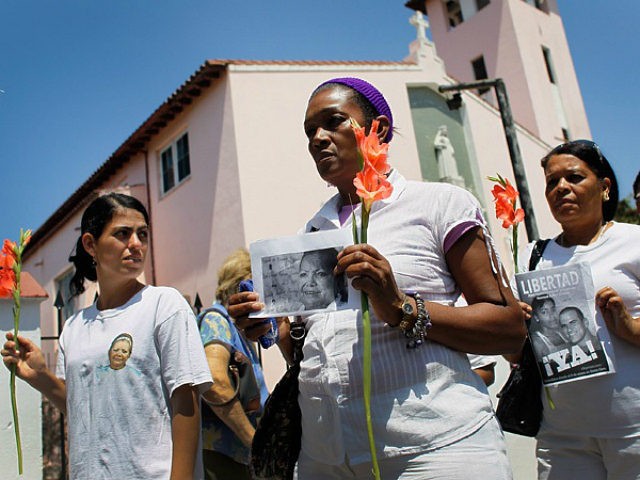Following the announcement that Fidel Castro, the 90-year-old former dictator of Cuba, had died, many are asking whether his demise will aid the Cuban dissident movement or whether his brother will continue to rule with an iron fist.
Central to the question of whether Fidel Castro’s death is a moment of opportunity for Cubans are the leaders of the island’s dissident movements. Among the most renowned group is the Ladies in White (Damas de Blanco), a collective of mothers, sisters, daughters, and wives of political prisoners. While Raúl Castro continues to deny the existence of prisoners of conscience in Cuba, the Ladies in White carry their pictures with them in a public march every week, insisting they are not forgotten.
The group was founded in 2003 by Laura Pollán, a schoolteacher whose husband Hector Maseda suffered a politically-motivated arrest as part of the larger crackdown on anti-communist dissidents now known as the Black Spring of 2003. Maseda endured eight years in prison, released only as part of an international diplomatic deal involving the Catholic Church. Maseda was released in February 2003; in October of that same year, Pollán died.
The women have carried on Pollán’s legacy, even those whose relatives have been released as part of plea deals. Now leading the group is Berta Soler, whose husband Ángel Moya was released as part of the same negotiation that saw Maseda liberated. Like Pollán, Soler has stated that she was a housewife before her husband was arrested for his political beliefs, even admitting that Moya was “very sexist” in objecting to her participation in politics, though stating in an interview before his release that he had joked to her that she would need to teach him how to be an activist by the time he got out.
Moya got out and now fully supports Soler’s endeavors, marching along with the Ladies in White and their allies every Sunday. Under Soler’s leadership, the Ladies in White have maintained the Sunday schedule set by Pollán: Catholic Mass in the same Havana church every morning, followed by a silent walk, often holding flowers or photos of their imprisoned loved ones. For this, the Ladies are arrested nearly every Sunday, beaten and dragged into buses by state police.
On some occasions, the Ladies are attacked with tar, punched, and scratched by a mob.
Many Ladies in White do not live in Havana and so practice their own ceremony every Sunday without the protection that the larger numbers provide. In some regions, like Las Villas, the Catholic Church has acted to prevent them from attending Mass in order to appease the Cuban government.
In Havana, the oppression of Ladies in White assemblies is never louder than in the context of Cuba’s relationship with the United States. In August 2015, over 90 dissidents — both Ladies in White and allies — were arrested for conducting the weekly march wearing masks of President Barack Obama as a form of protest against the President’s thawing of relations with the Castro dictatorship.
Another 100 were arrested in 2014 for commemorating the anniversary of the incident known as the March 13 tugboat massacre, in which Fidel Castro ordered the drowning of dozens of children, some as young as six months old, and their parents attempting to escape Cuba en route to the United States.
In March, the month President Obama visited the island, Berta Soler was arrested eight times.
The Ladies in White have made clear that they will continue advocating for the liberties of those imprisoned by the communist regime. They have taken one extraordinary measure in light of Castro’s death, however: for the first time in 13 years, they did not march on Sunday. While exiled Ladies in White celebrated his death in Miami, Soler said she called off the march “so that the government does not take it as a provocation and so that they can pay their tributes.”
“We have decided, as fighters of human rights groups, to respect the pain, which we don’t share,” Soler said in a statement.

COMMENTS
Please let us know if you're having issues with commenting.